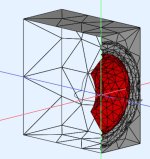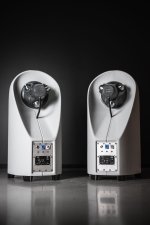Nov 2023 paper by R&D Team Panzer J, Macey P: Experimental and theoretical investigation of an unusually shaped horn; IOA Reproduced Sound RS39, Bristol UK, Nov 2023
I don't understand any of this. Is R&D trying to figure out how to model a device similar to the LF extension? It places the horn at the exit of the phase plug and examines simulation methods of the throat impedance. They plan further work on modeling the compression driver to simulate absolute pressure values. (PDF attached)
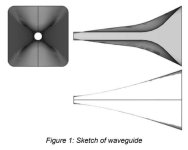
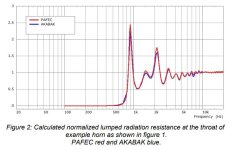

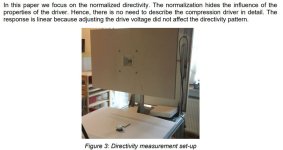

I don't understand any of this. Is R&D trying to figure out how to model a device similar to the LF extension? It places the horn at the exit of the phase plug and examines simulation methods of the throat impedance. They plan further work on modeling the compression driver to simulate absolute pressure values. (PDF attached)





Attachments
That would be great, as something is definitely missing. I would love to proceed with this as well, but I'm simply not competent enough. It would be great to be able to measure a real driver and make a corresponding model usable for this kind of optimization. Maybe some damping added somewhere in the current models is all it takes, who knows.They plan further work on modeling the compression driver to simulate absolute pressure values.
Last edited:
hey, we wanted to share the birth of another ATH MEH horn loudspeaker with you.
A 440mm ATH horn with throat extension was the basis with midrange ports for 3 4" mids. A 12" driver with a 12" passive radiator takes care of the low end. It's a 3 way design with amplification and dsp onboard.
If you'd like to get the .cfg files from which the horn is generated let us know. We can share them here.
We've posted some build details in the ath-practical-way-thread. Thanks @mabat for sharing your work and @bmc0 for your directivity scripts here

A 440mm ATH horn with throat extension was the basis with midrange ports for 3 4" mids. A 12" driver with a 12" passive radiator takes care of the low end. It's a 3 way design with amplification and dsp onboard.
If you'd like to get the .cfg files from which the horn is generated let us know. We can share them here.
We've posted some build details in the ath-practical-way-thread. Thanks @mabat for sharing your work and @bmc0 for your directivity scripts here
Attachments
Have you tried to check your actual bed temperature? Sometimes the sensor which sits on the underside is way off from the actual bed temperature.Frustrated by warping and waking up to multi hour prints turning into spaghetti when a first layer releases overnight. Trying a raft with tape this time.
View attachment 1236821
As for the warping of 3D prints, that's one of the reasons why I started making the hexagonal-shaped horns with sharp wall joints. Even if all these little imperfections add up, with the segmented shape it can be hidden pretty succesfully at the joints. Not so easily with round shapes - all is visible on a shape that was meant to be perfectly round.
Last edited:
Funny, as I think that if I tweaked the Tritonia parameters a bit, I would get quite the same.
BTW, the original Tritonia waveguide was designed for a 1.4" throat, and I still have the prototype. What I plan is to test an LF extension for a 1" driver. That could make it also an interesting option for a baffle-mounted device.
BTW, the original Tritonia waveguide was designed for a 1.4" throat, and I still have the prototype. What I plan is to test an LF extension for a 1" driver. That could make it also an interesting option for a baffle-mounted device.
Last edited:
I really like the back of the horn:

It looks like it is autogenerated somehow. It should make the waveguide pretty solid and non-resonant.
It looks like it is autogenerated somehow. It should make the waveguide pretty solid and non-resonant.
So this being the realm of experts and enthusiasts with horns, i have a question
So JBL had some great critical acclaim over their Synthesis 1400 system which used a tall but narrow mid horn that supposedly has a 60 degree horizontal pattern.....i can't see that by looking at the thing. And also, the tall length of the horn having only 40 degrees radiation is often referred to as the 'special sauce ' of the system. Anyone familiar with the system and what's actually going on here?
So JBL had some great critical acclaim over their Synthesis 1400 system which used a tall but narrow mid horn that supposedly has a 60 degree horizontal pattern.....i can't see that by looking at the thing. And also, the tall length of the horn having only 40 degrees radiation is often referred to as the 'special sauce ' of the system. Anyone familiar with the system and what's actually going on here?
It's hard to believe it's not based directly on my work but I'm sure they would mention it, at least 🙄
Code:
; -------------------------------------------------------
; Tritonia Waveguide-X / Ath script code
; -------------------------------------------------------
Throat.Diameter = 36 ; [mm]
Throat.Angle = 0 ; [deg]
Throat.Profile = 1
Length = 140 ; [mm]
Coverage.Angle = 38 - 20*cos(2*p)^5 - 25*sin(p)^12
Term.s = 0.7 + 0.2*cos(p)^2
Term.n = 3.7
Term.q = 0.995
Slot.Length = 20*sin(p)^4
Morph.TargetShape = 1
Morph.FixedPart = 0.0
Morph.Rate = 3
Morph.CornerRadius = 4
Morph.TargetWidth = 400
Mesh.AngularSegments = 100
Mesh.LengthSegments = 26
Mesh.CornerSegments = 4
Mesh.ThroatResolution = 5
Mesh.MouthResolution = 10
Mesh.InterfaceResolution = 8
ABEC.SimType = 1
ABEC.f1 = 400 ; [Hz]
ABEC.f2 = 12000 ; [Hz]
ABEC.NumFrequencies = 40
ABEC.MeshFrequency = 1000 ; [Hz]
ABEC.Polars:SPL_H = {
MapAngleRange = 0,90,19
Distance = 2 ; [m]
}
ABEC.Polars:SPL_V = {
MapAngleRange = 0,90,19
Distance = 2 ; [m]
Inclination = 90
}
_ABEC.Polars:SPL_D = {
MapAngleRange = 0,90,19
Distance = 2 ; [m]
Offset = 145
Inclination = 42
}
Output.STL = 1
Output.ABECProject = 1
Report = {
Title = Tritonia-X
PolarData = SPL_H
Offset = 145
NormAngle = 10
}
Last edited:
I wonder how they managed to get away without any traces of baffle related waist-banding or if their sonograms are taken from the biggest 15"/40 cm device.
These are from @NicoB who uses COMSOL, so it is quite likely that COMSOL tweaked the geometry to match a targetIt's hard to believe it's not based directly on my work but I'm sure they would mention it, at least 🙄
https://www.diyaudio.com/community/...nd-bem-simulation-results.382115/post-7508971
Confirmation: the sonograms show a 44 cm wide device. Very good for a wide baffle approach as with the Grimm Audio LS1. And at the same time benefiting from a narrow pattern: would be interested to see a 120 degree device, especially on a narrower baffle like 30 cm or so.
After digging:
speedbad = @NicoB?
https://www.homecinema-fr.com/forum...-pour-compression-1-1-4-1-5-t30127528-15.html
https://www.homecinema-fr.com/forum...-pour-compression-1-1-4-1-5-t30127528-90.html
In French so you'll need help from your preferred translator tool:
@mabat is mentioned
speedbad = @NicoB?
https://www.homecinema-fr.com/forum...-pour-compression-1-1-4-1-5-t30127528-15.html
https://www.homecinema-fr.com/forum...-pour-compression-1-1-4-1-5-t30127528-90.html
In French so you'll need help from your preferred translator tool:
I am not looking for controversies just sharing information that may or may not be relevant from an acoustics POV.Alors ni oui ni non Alex, je n'utilise pas d'outil d'autres, j'utilise des formules mathématiques d'autres mais "bas niveaux", lois de surface, OS, algo FEA...
mabat lui a bien de meilleurs connaissances en math et fait évoluer la formule OS et autres pas de soucis la dessus son outil et super et je le recommande a ceux qui veulent juste imprimer un OS.
Mais son outil ne m'est d'aucune aide, de même que celui de Dario Cinnani que j'avais acheté, j'ai tout réimplémenté (enfin ce dont j'avais besoin) d'une autre façon en math+géométrie pour ne pas travailler en nuage de point et mon FEA est "maison".
Ce sont des modèle mathématico géométrique, c'est une autre approche plus proche de ce que je fais JBL aujourd'hui, ils l'ont d'ailleur détaillé à l'époque de la M2, ma méthode est proche.
Idem PURIFI avec qui j'ai été en contact (le cofondateur qui fait de la simu), on a quasiment la même façon de faire, cf le WG de leur derniere tweeter (calcul plus léger en mémoire car 2D autour d'un axe, un PC gamer suffit en gros, savoir orienter sa machine de calcul vers ce que l'on veut faire fait partie du job).
Mais comme l'a démontré Kohlberg, dont j'ai lu le livre et qui est intervenu sur DIYaudio, il y a FEA et BEM open source, un monde sépare les deux, AKABAK et autre ne m'est aussi d'aucune utilité.
il ne faut pas confondre l'usage d'outil qui te sorte un "mp3" imprimable, un nuage de point c'est le mp3 du monde du pav, je ne peux quasi rien en faire, et comparer ça à utiliser des algo ou formule "souche" à la JBL ou PURIFI.
On repart tous des connaissances des autres, tout en sachant que ces grands nom mort ou vivant n'étaient/ne sont pas tous d'accord (règlement de compte par livre interposé parfois), n'avaient pas forcément la même vision des choses et parfois même ont des clichés surprenant, Geedes en est un bon exemple, ils sont spécialisé dans ce qu'il ont créés pour certains, parfois même bloqués sur ce qu'ils ont créés, c'est frappant parfois mais c'est humain.
Pour ce qui est des tests de MaBat sur ce genre de chose à l'époque mais aussi le topic de batman (M2 for the poor ou quelque chose comme ça), il y a du fantasme et de grosses incompréhensions sur le fonctionnement de ces pav.
A l'époque Kolberg m'avait dit qu'il aimerait travailler sur les pav type M2, car ils ne sont pas dans son bouquin, nul doute que s'il se penche dessus il y arrivera aussi et plus vite que moi.
Je ne revendique aucun titre mais on est loin de juste utiliser des outils pré mâchés open sources (ou payant dans le cas de Cinnani) avec du temps ou même une formule toute faite.
@mabat is mentioned
That's just how Tritonia waveguide behaves:
https://www.diyaudio.com/community/...-design-the-easy-way-ath4.338806/post-6541384
https://www.diyaudio.com/community/...-design-the-easy-way-ath4.338806/post-6548452
That website is obviously selling my work without even mentioning anything of it. I could be rightly pissed off, and I am.
https://www.diyaudio.com/community/...-design-the-easy-way-ath4.338806/post-6541384
https://www.diyaudio.com/community/...-design-the-easy-way-ath4.338806/post-6548452
That website is obviously selling my work without even mentioning anything of it. I could be rightly pissed off, and I am.
Last edited:
Hello,
It seems peoples talk about me without knowing nothing :
1 . I work on OS Geedees Formula with Elliptic transition and X-Shape before Ath4 even exist (in public, I don't know when he start on it), so ATH4 have nothing to do with my work and like I said in french their is a part of fantasy/miss understanding about M2 like horn, it still the case.
Even with the OS free air version It's NOT Ath4 with R-OSSE, but I advise people that want to simply do an OS horn to use Ath4, it's simpler for DIY user that do what I do. But there is no one way to achieve a goal, see point 4
2 . I'm a specialist in Constant Directivity Horn, It make years, for find how do a correct X-Shape and the way mabat show it is wrong, as JBL does mistake too, it's on my website too so I don't have to help people to solve her mistakes, I thinks I have already explained a lot and even too much, even with polar their is something you cannot see if you just do an horizontal polar at 0° vertical and a vertical polar at 0° horizontal, and it's exactly the same for simulation.
Resuming my years of work on super computer by a copy is an insult.
3. Yes ALL my horn, ALL X-Shape, and the Biradial next gen too, OS free air too, OS in box too, completely remove the effect of the baffle aka the midrange narrowing and beaming described by Kolbrek. It's in his book.
4 . I use in house personal FEA system as Kolbrek does, allowing to do FEA with less super computer than usual and literally see the wavefront, people that know me or work with me know that I cannot simulate or modify a STL or mesh model, it's like ask me to do a mastering with a mp3, I work in geometric, not in mesh. It's not how my FEA work, BEM is not FEA and there is a lot things in FEA.
5 . The back in not generated I spend time on it for some reason too.
6 . There is no point to do a 120° version except for listening at less that 1.5m but even there the 90° will still work because you will have almost only direct field so... except is you have 10 lateral position at 1m50...
Even in studio mastering it's not really happen but they work differently, the RT is very low, they absorb even on the side so they can use 120° horn as early reflection is very absorbed on side wall, but bring studio way to do in a saloon or even in a dedicated listening HC/Hi-Fi room is a big mistake, as use a M2 in a saloon at more than 2m make absolutely non sens and some professional doesn't like this speaker for this and it's not the only one reason (don't ask me to give names and look https://www.erinsaudiocorner.com/ to start to understand).
We listen at critical distance when the radio direct field against reverberated field is 50/50 or 60/40,40/60.
Read the work of Dr Floyd Toole (https://floydtoole.academia.edu/) in acoustics and psycho acoustic, coverage is adapted to distance and psycho acoustics ( room shape also affect it but it will make too many time to explain).
Then you will realize that just choose 120° because the woofer is also close to 120° before it become directive is a non sens, we do it with WG without evolved phase plug because tweeters doesn't allow to go against the 120° natural radiation of tweeter. it's why we cut where the woofer become directive, it's acoustics basics.
But as you have see I guess I have developed a special Phase plug for put a SB26ADC in a X-Shape 1" throat not modified.
Has a result the same polar than a BMS 5530 (1") but to many loading ("rich" problem).
I currently work for do the same with a rectangular OS 90°, that is far more difficult that 120° one.
7 . There is a professional word may be not completely visible here with competence that are incredible high in simulation (custom), they post rarely but they are more advanced that you can imagine.
Conclusion: I have a deep respect for Mabat works and what he bring to DIY community and on math side I'm sure he is a lot better than me but it doesn't mean that all audio pro cannot do good things or better design on their own and make their own tool, ask it to Kolbrek...
It seems peoples talk about me without knowing nothing :
1 . I work on OS Geedees Formula with Elliptic transition and X-Shape before Ath4 even exist (in public, I don't know when he start on it), so ATH4 have nothing to do with my work and like I said in french their is a part of fantasy/miss understanding about M2 like horn, it still the case.
Even with the OS free air version It's NOT Ath4 with R-OSSE, but I advise people that want to simply do an OS horn to use Ath4, it's simpler for DIY user that do what I do. But there is no one way to achieve a goal, see point 4
2 . I'm a specialist in Constant Directivity Horn, It make years, for find how do a correct X-Shape and the way mabat show it is wrong, as JBL does mistake too, it's on my website too so I don't have to help people to solve her mistakes, I thinks I have already explained a lot and even too much, even with polar their is something you cannot see if you just do an horizontal polar at 0° vertical and a vertical polar at 0° horizontal, and it's exactly the same for simulation.
Resuming my years of work on super computer by a copy is an insult.
3. Yes ALL my horn, ALL X-Shape, and the Biradial next gen too, OS free air too, OS in box too, completely remove the effect of the baffle aka the midrange narrowing and beaming described by Kolbrek. It's in his book.
4 . I use in house personal FEA system as Kolbrek does, allowing to do FEA with less super computer than usual and literally see the wavefront, people that know me or work with me know that I cannot simulate or modify a STL or mesh model, it's like ask me to do a mastering with a mp3, I work in geometric, not in mesh. It's not how my FEA work, BEM is not FEA and there is a lot things in FEA.
5 . The back in not generated I spend time on it for some reason too.
6 . There is no point to do a 120° version except for listening at less that 1.5m but even there the 90° will still work because you will have almost only direct field so... except is you have 10 lateral position at 1m50...
Even in studio mastering it's not really happen but they work differently, the RT is very low, they absorb even on the side so they can use 120° horn as early reflection is very absorbed on side wall, but bring studio way to do in a saloon or even in a dedicated listening HC/Hi-Fi room is a big mistake, as use a M2 in a saloon at more than 2m make absolutely non sens and some professional doesn't like this speaker for this and it's not the only one reason (don't ask me to give names and look https://www.erinsaudiocorner.com/ to start to understand).
We listen at critical distance when the radio direct field against reverberated field is 50/50 or 60/40,40/60.
Read the work of Dr Floyd Toole (https://floydtoole.academia.edu/) in acoustics and psycho acoustic, coverage is adapted to distance and psycho acoustics ( room shape also affect it but it will make too many time to explain).
Then you will realize that just choose 120° because the woofer is also close to 120° before it become directive is a non sens, we do it with WG without evolved phase plug because tweeters doesn't allow to go against the 120° natural radiation of tweeter. it's why we cut where the woofer become directive, it's acoustics basics.
But as you have see I guess I have developed a special Phase plug for put a SB26ADC in a X-Shape 1" throat not modified.
Has a result the same polar than a BMS 5530 (1") but to many loading ("rich" problem).
I currently work for do the same with a rectangular OS 90°, that is far more difficult that 120° one.
7 . There is a professional word may be not completely visible here with competence that are incredible high in simulation (custom), they post rarely but they are more advanced that you can imagine.
Conclusion: I have a deep respect for Mabat works and what he bring to DIY community and on math side I'm sure he is a lot better than me but it doesn't mean that all audio pro cannot do good things or better design on their own and make their own tool, ask it to Kolbrek...
6 . There is no point to do a 120° version except for listening at less that 1.5m but even there the 90° will still work because you will have almost only direct field so... except is you have 10 lateral position at 1m50...
I did not want to lessen your effort or criticize your design choices, sorry if this did not came through. It is simply my own understanding that a wider horizontal radiation pattern is necessary for a wide soundstage and big image, and this is something that I am looking into with shallower waveguides.
3. Yes ALL my horn, ALL X-Shape, and the Biradial next gen too, OS free air too, OS in box too, completely remove the effect of the baffle aka the midrange narrowing and beaming described by Kolbrek. It's in his book.
This is very interesting. I could not solve this issue via trial and error and ran out of patience to wait for the computation time on my workstation computer. Could you share the literature and maybe leave a hint which chapter addresses the precise issue? That would be very kind.
As for the rest, I will stay out of the argument.
- Home
- Loudspeakers
- Multi-Way
- Acoustic Horn Design – The Easy Way (Ath4)

